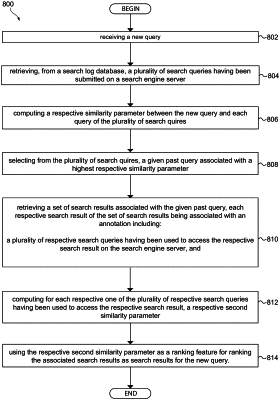| CPC G06F 16/24578 (2019.01) [G06F 16/953 (2019.01)] | 22 Claims |

|
1. A computer-implemented method for ranking search results using a first machine learning algorithm (MLA), the method being executed by a server hosting a second MLA, the second MLA having been trained to determine query similarity, the method comprising:
receiving, by the second MLA, a new query;
retrieving, by the second MLA from a search log database, a plurality of search queries having been submitted on a search engine server;
computing, by the second MLA, a first similarity parameter between the new query and each query of the plurality of search queries, the first similarity parameter being determined based on one or more textual features of the new query and each query of the plurality of search queries;
selecting, by the second MLA, from the plurality of search queries, a first past query associated with a highest first similarity parameter;
retrieving, by the second MLA, a set of search results associated with the first past query, the set of search results including a first search result associated with:
a first annotation including:
a second past query having been used to access the first search result on the search engine server, the second past query being different from the new query and the first past query;
a first user-interaction parameter indicative of user behavior with the first search result in response to the second past query having been used to access the first search result on the search engine server;
a second annotation including:
a third past query having been used to access the first search result on the search engine server, the third past query being different from the new query, the first past query and the second past query;
a second user-interaction parameter indicative of user behavior with the first search result in response to the third past query having been used to access the first search result on the search engine server;
computing, by the second MLA, a second similarity parameter for each of the second past query and third past query, the second similarity parameter being computed by:
determining a third similarity parameter between the new query and each of the second past query and third past query, the third similarity parameter being determined based on one or more textual features of the new query and each of the second past query and third past query;
multiplying the third similarity parameter associated with the second past query with the first user-interaction parameter; and
multiplying the third similarity parameter associated with the third past query with the second user-interaction parameter;
in response to the second similarity parameter associated with the second past query being higher than the second similarity parameter associated with the third past query, using the second similarity parameter associated with the second past query as a ranking feature by the first MLA for ranking the associated set of search results as search results for the new query.
|